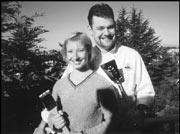CULINARY COMMUNION 206-284-8687 BLUE RIBBON COOKING SCHOOL 206-328-2442
Heidi Kenyon and Gabe Claycamp’s place is fairly typical for the west side of Queen Anne Hill. It’s smallish and a bit overgrown on the street side, but redeemed by the sound-and-mountain view shared by a few people at a time, over dinner and drinks, some laughs, and friendship.
That’s exactly what Claycamp and Kenyon do: two, three, four, five, six days a week. Only the friends they have over, eight at a time, are happy to pay the costs of the party and even happier to crowd into Claycamp’s kitchen and do most of the work and cooking. The little house is, in fact, a culinary academy (as well as maison Claycamp-Kenyon). But the laughs and friendship are as important a part of the program as instruction in knife skills or boning a gigot. More important, perhaps: The proprietors recognized that when they decided to call their school Culinary Communion.
Does that name make you cringe a bit? It did me, when I first heard it: It conjured up vague images of religious fanatics in culinary disguise recruiting a congregation through the kitchen door. Well, I was wrong. Kenyon and Claycamp do have a “spiritual” agenda, but there’s nothing covert or mystical about it. They believe that the preparing and sharing of food in common is one path to recapturing a civility and sense of community largely lost from everyday urban American life. You don’t need to say a sectarian grace over a meal you’ve prepared in common with others, whether family, friends, or total strangers; in a strange way, the grace is the meal.
LOTS OF YOUNG couples might have come up with the notion that turned into Culinary Communion. Few would have done it so meticulously as Claycamp and Kenyon. Claycamp was born in a hippie A-frame near Mary’s Corner, Wash., and his first real job was at the Centralia branch of Shari’s, but he seems to have known from childhood that fine food was his destiny. He cooked his first dinner party for friends at 15: “tortellini stuffed with artichokes, black olives, and toasted walnuts; baked brie; and, as I remember, really bad red wine.” That same year, he lied his way into Centralia Community College. He had a more difficult time wangling admission to the Culinary Institute of America, but still managed to graduate from the prestigious Hyde Park, N.Y., academy at age 20. But even as he scored a job at one of New York’s most admired boutique restaurants, he was thinking about teaching instead—teaching adults, not just to cook, but to know and respect the ingredients they cooked with, their quality, freshness, seasonality, and uniqueness.
When Claycamp met Kenyon, she was waitressing at the Olympia Anthony’s where he was a sous-chef. They moved in together in late 2000; the idea of Culinary Communion was born soon after. “It was the perfect collaboration,” says Kenyon, a Northwest native with a background in publishing and marketing. “I was a big foodie, read all the food magazines, and didn’t know anything about cooking.”
The new team took their time “doing the numbers,” writing a 100-page business plan, and watching the crowd at culinary events and exhibitions to research their target market. Finally, with no facility yet to teach in, let alone equipment to teach with, they had 1,000 postcards printed, invested in a booth at the 2001 Seattle Cooks, and sailed into the unknown. At the end of the four-day event, they had the names of 997 potential students.
In 2002, CC’s first full year of operation, Claycamp taught all the classes while Kenyon ran the business, but the operation’s grown so quickly that this month K䲥n Jurgensen is leaving Baci Catering to join CC’s teaching staff full time. The Queen Anne location is at the limit of its capacity, and the partners are actively encouraging would-be students to offer their own homes for classes, in exchange for discounted tuition.
SOME PEOPLE MAY find the notion of rubbing elbows with strangers while trying to master the art of mincing garlic off-putting. But for many of the students at Culinary Communion (or at other home-based operations like Virginia and Mike Duppenthaler’s seven-year-old Blue Ribbon Cooking School in Madison Park), companionship is one of the most agreeable aspects of the experience. Corporate human-resource departments have taken note and agree: The majority of the Duppenthalers’ classes are booked as employee perks by companies like Microsoft and Starbucks.
The key to both programs is the hands-on element: Watching a celebrated chef deftly whomp up a delectable meal is fine, but essentially no different from the experience of watching a TV cooking show. It’s the shared sensory experience of turning raw materials into food that links classmates together. “Team building” is just corporatespeak for healthy human interaction, and nothing promotes trust and sympathy as much as making something together. Just look at kids building a sand castle. Is that so different from assembling a faisan farci en crote?









